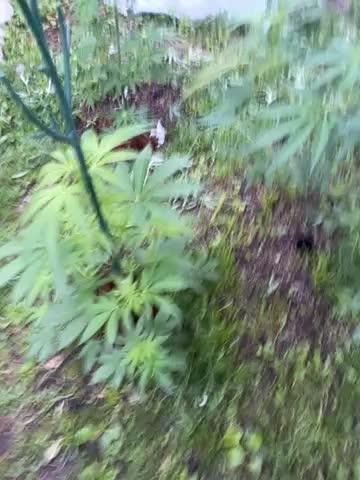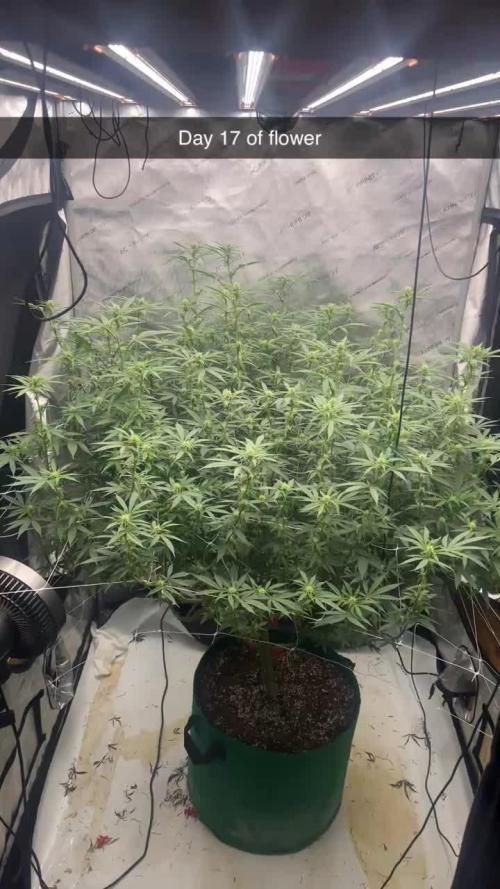The Grow Awards 2026 🏆 






























Likes
4
Share

Likes
21
Share


@GrowGuy97
Follow
Day 35 - Everything is going great so far, the Gorilla Girl is pretty short but smells amazing so far & has a lot of bud sites so I’m very curious to see how she turns out! Make sure to check back for updates & happy growing friends!✌️🏼🙏🏼🌱
Processing
Likes
10
Share


@Vegas_Kind_Budz
Follow
8/16/2020
Not too many changes, starting to lower the amount of nutrients and just adding bloom, just watching the birds fattening up getting ready to do a flush in about 2 1/2 weeks, hopefully end up with some good quality flavorful bud
Likes
14
Share


@Fre_84
Follow
Hi everyone. By now a fat banana has come to an end. With next week I will proceed to the cut. Now it is being fed only on water (ph 6.2) The other little fat banana was infected with a caterpillar that was eating the stem internally. I eliminated the parasite and treated the wound of the plant with a totally natural product. It seems to me that he reacted well. The northern light proceeds ... it is still behind.
Likes
10
Share


@SouthGermanGrowGirl
Follow
Week5 here on the 31.08.2025
Gina (White Widow auto) grows very good so far.
Get every 3-4 Days about 15L Water with Nutrients (Metrop MR1+2+AminoXtreme)
Buds are building too
Likes
23
Share


@DoubleDsTrees
Follow
Looking closer and closer to being finished with this one.. I lowered the ppms down to 600. May need to go lower most the tops look like they are finishing up. This one is pretty massive filling my 5x5 tent pretty good and the root production out of this 6" net cup is pretty gnarly. Definitely not lacking any quality either. Buds smell delicious and are super sticky.
Likes
7
Share


@Rusty_Shackleford
Follow
My 3 Jack Herers' have started to pre-flower. Nutrients will be the transitional between veg and bloom . Lots of side branching on all the plants with Ellie may trailing behind
Likes
5
Share


@CreoWeed
Follow
Hey guys,
The week went pretty smoothly and flowers are starting building up.
I'll soon introduce Bloombastic for 10 days, increasing from 0.5 to 1.5 ml per liter.
Other than that, this phenotype are bringing out some gorgeous color, and they are starting to smell.
Now she's finally alone in the tent so I hope she will build up a little more.
For now, thats all lads.
Stay tuned, stay high!
Likes
6
Share


@Mr_nugs_lover_David
Follow
She's showing the first pistils already, she looks veery small for 28 days old, can't believe it, I was very excited about this strain and looks like she's not gonna be very productive,but let's see how big she get with the stretch. Peace and love everybody 💚✌️
Likes
37
Share


@ActioPauliana
Follow
Music in video:
Niwel - Cold Sky
➡️ TWITTER: https://twitter.com/NiwelMusic17
➡️ INSTAGRAM: https://www.instagram.com/niwel17/?hl=fr
➡️ SOUNDCLOUD: https://soundcloud.com/niwel-516897768
➡️ FACEBOOK: https://www.facebook.com/Niwel-Music-261718784171967/
CONTACT: [email protected]
********************************************
This week, I was welcomed in a special club. It became clear to me when I opened the tent two days ago. There they were, sticking out one of the main cola’s, it was almost impossible to miss them: 2 bright lime green banana’s. It was like the little dicks were smiling to me. I immediately removed them and search all the plants thoroughly multiple times for more, but didn’t found one. So, I guess I’m now a member of the ‘hermies club’.
As for the cause: I suspect light stress. The light was close on the canopy, a little closer than (for example) dr. Cocoforcannabis recommends for this light. I found the two banana’s on Jannine and the bud that had them, is the one that’s almost in the middle of the tent, where the light is the brightest. The plant on the left, Kim, was also showing some foxtailing on her highest buds. Hence, I raised the lights 6-7 centimeters. Hopefully, I took away the cause of the hermies; off course, I’m keeping a sharp eye on the buds, but I haven’t found any more than those two.
Also, EC of the drain tends to go up, hence every few days, I now just give them plain pH’ed water, to prevent high EC spikes.
The trichomes are developing nicely. I bought a jeweler's loupe to study them, because with my USB microscope it’s almost impossible to get a clear picture (I don’t have a steady hand). The girls are 7 weeks into flower: there are no amber trichomes, but most trichomes are partly cloudy (30~50%) and a minority is still fully clear. I guess two more weeks before harvest, maybe 1,5 week. I switch to GHE Ripen later this week. I didn’t use such a product during my first grow, so I’m curious to see if it does something good.
Besides the two (hopefully sterile) banana’s, the plants look and smell great.
Thanks for stopping by, stay safe & keep growing!
Likes
11
Share


@DimJesus
Follow
Saludos 🙌 completando la séptima semana y comienzo de floración 🙏
Cambié el fotoperiodo el día 2/04 y la planta dió una buena crecida desde entonces. Comenzó a oler un poco más también pero todavía sin señales de pistillos, ansioso para verlos.
Buenos humos 🍃
Likes
170
Share


@Tropicannibis_Todd
Follow
👉Alrighty Then👈
This plant finished out just around 90 days from seed
👉Puffed a bunch of it , and its fire and I mean fire , Grape Berry mixed with a little earthy undertone 👈 the buds are tight and smoothered in resin 👌
Would definitely grow this one again and would recommend 😳 Facts
Persian Pie from Greenhouseseeds
Full Gas from Greenhouseseeds
Babba Kush from Greenhouseseeds
Rainbow Melon from Fastbuds
Papaya Sherbet from Fastbuds
Weddingcheesecake FF From Fastbuds
Purple Oreoz F1 From Seedsman
Slurricane From Premium Cultivars
Soil by Promix
Nutrients by Cronks
This was a crap ton fun 🙃
Thanks to all my growmies out there for stopping by its much appreciated 👈
👉Happy Growing👈
Processing
Likes
3
Share


@420cfm
Follow
Week 8! Home stretch now. I'm seeing a few nanners so I'm tempted to pull this week instead of next. Will give them a few days to see how they do with the new reservoir refill and go from there! Lots of crystal build up even if the nanners kick my butt.
Likes
4
Share


@Mo_Powers
Follow
not much has happened this week. there is still some sun per day. however, the temperatures drop to 4-8 degrees at night. these are not exactly the best conditions. maybe this late outdoor experiment was not a good idea after all. however, they have not died yet.
Likes
50
Share


@HerbalEdu
Follow
expected flowering: 7-8 weeks
Germination method: cotton disc with tap water with 4ml/l root juice and 1ml/l acti-vera
Tent: BlackBox Silver 90x60x180cm (3'x2'x6')
Extractor: 220 m³/h
Soil: Biobizz All-Mix
SF-2000 @85cm @50%
germination: 10/11 They took a little longer than usual to open up, all but one seem to grow vigorously enough afterward.
sprout: 9/10 ; 9 transplanted in soil at first then another one transplanted 36H later i may transplant the last one if the root finally start to grow. First two are showing 20h after transplant. 35h after transplant 7 are showing. 42H after transplant 9 are showing and seem to form their first set of true leaves normally. Last one showed a little later but doesn't seem to form it's first true set of leaves.
Processing
Likes
2
Share


@FolloMiSensi
Follow
Tent filling up. Week 6 left, week 5 right. Topped up res, slowing transitioning to bloom regiment. Minor lst adjustments to even out canopy.



























